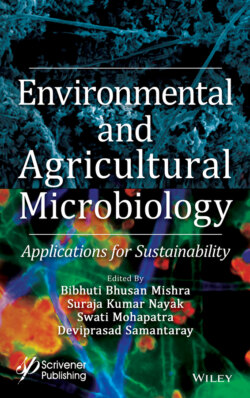Читать книгу Environmental and Agricultural Microbiology - Группа авторов - Страница 70
4.1 Introduction
ОглавлениеResearch and development in the field of materials science over the past two decades have dramatically increased the production of synthetic or bio-based polymers [1, 2]. Plastics are usually hard to decompose but marginally affected by exposure to natural conditions such as sunlight, heat, oxygen, or biological and hydrolytic processes. Long-term undesirable accumulation of plastics in soil and water imposes a significant threat to the environment, and it can take from a year to decades for them to decompose [1–3]. Rising demands of plastics in both commercial and domestic sectors make it challenging for its proper disposal [4]. Although, several methods such as modification of molecular structure, side chain, reinforcement, and addition of some side-chain in plastics were developed, aiming to plastic waste management [5]. However, these modifications affect its molecular chain, morphology, chemistry, degree of polymerization, thermal properties, and hydrolytic behaviors [5]. There are widely used synthetic or bio-based polymers like polyamide (PA), polylactic acid (PLA), and polyhydroxyalkanoates (PHAs) with low melting temperature and degraded faster than other high-performance polymers such as PBO (polybenzoxazole), PBI (polybenzimidazole), and PI (polyimide) [1–3]. PAs were considered to be exciting materials since 1930 due to its molecular structure (-CONH-). However, its fibers are resistant to biodegradation because of chain symmetry [6]. But nylon degradation can occur after side-chain modification; scission of the chain, as well as a low oligomer, can be degraded [6, 7]. Hashimoto and Naoka et al. reported about especially nylon 4 degrade under the soil in the presence of marine bacteria [7, 8]. Recently, Kaneko et al. (2014) reported itaconic acid-based heterocyclic PAs, which are environmentally degradable under soil and water in the presence of UV light [8]. Naturally occurring polymers, bio-derived plastics, and synthetic bio-based plastics from renewable resources are the existing bases for establishing a sustainable society [9, 10]. Replacing bio-sourced materials over the existing fossil-fuel-based plastics are the prime focus of recent research [9]. However, different microbial-derived well-known bio-polyester like PHAs and PLA has low melting temperature tensile strength, and its biodegradable nature can replace the petrochemical-based plastics. There are various methods for the degradation of the polymer.
1 1. Thermal degradation
2 2. Photo-oxidative degradation
3 3. Hydrolytic degradation
4 4. Mechanochemical degradation
5 5. Soil degradation
6 6. Biodegradation
Some of the factors that affect the degradation process such as
- Color changes
- Scission of the backbone
- Modification of one or more end-groups
- Disruption of a side chain
- Mechanical
- Photo/thermal
- Chemical
- Cracking and charring (weight loss)
- The effect of light, heat, air, and moisture reflects the polymer structure.
Biodegradation can be defined as the breaking down material when exposed to microbes such as bacteria, fungi, actinobacteria, or other biological means anaerobically or aerobically [2]. Moreover, polymers biodegradation is possible by different enzymatic and non-enzymatic hydrolysis without thermal oxidation, radiolysis, or photolysis [3]. Alternatives to the existing fossil fuel and other non-renewable sources are the prime focus of today now. This chapter describes the broad spectrum of bioavailability, biosynthesis and biodegradability of PA, PLA, and PHAs.
